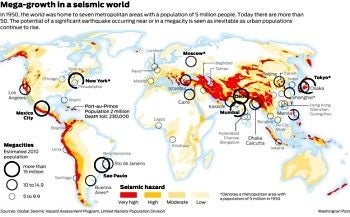
La página que intenta visitar sólo está disponible en inglés. ¡Disculpa!
The page you are about to visit is currently only available in English. Sorry!


Graphic from the Washington Post
The deadly earthquake in Chile last week killed at least 700 people and displaced 2 million. A prediction of the event would’ve been invaluable, but while seismologists know where earthquakes are likely to occur, they can’t pinpoint exactly when and where they’ll happen.
"We don’t have any good way to predict earthquakes,” Jim Dieterich, a geophysicist at the University of California, Riverside and chair of the USGS National Earthquake Prediction Evaluation Council, told me after the 2008 earthquake in China’s Sichuan province. “In terms of short-term warning—from a few days or weeks—with high reliability, we’re just not there at this point."
There have been some successful predictions. Perhaps the most famous was in 1975, when, in response to fluctuating groundwater levels and bizarre animal behavior, Chinese officials evacuated a town hours before a 7.3-magnitude quake hit. Still, most scientists chalk that prediction, and others, up to luck.
Here’s more on the subject from an article in Plenty:
Instead of trying to predict earthquakes, in recent years geologists have turned their attention to forecasting them. Similar to a weather forecaster estimating a 40 percent chance of rain, scientists assess geological conditions and calculate the probabilities that quakes of certain sizes will occur during specific time periods in a given area. For example, a 2008 USGS study found that the chance of one or more 6.7 magnitude earthquakes hitting California in the next 30 years is greater than 99 percent. The information might not be helpful for, say, evacuating a city, but it can help shape emergency planning and other measures.
When an earthquake occurs, a fault, or crack in the Earth’s crust, ruptures, radiating seismic waves, like ripples from a stone tossed into a lake, causing damage as they pass through the ground.
Scientists develop forecasts by monitoring the motion of faults and gathering information on past earthquakes to figure out how regularly major ones take place.
But it’s not an exact science. Given the history of California’s Southern San Andreas Fault, you’d expect a major earthquake every 100 years, says Mary Lou Zoback, a geophysicist and vice president of earthquake risk applications at Risk Management Solutions, a company that specializes in catastrophe models for the insurance industry. “It’s been 300 years since the last big one there, so we give it a really high likelihood of going in the next 30 years."
Zoback was part of a team that monitored a segment of the San Andreas Fault near Parkfield, in central California, which seemed likely to rupture. Earlier in the century, quakes of about a 6.0 magnitude had occurred regularly, and researchers set up instruments to capture any activity before the next earthquake, which they expected to hit in the late 1980s. The quake didn’t happen until 2004, but all of the equipment was still in place to record the event.
“We had so many instruments, and there was not a single precursor. It just wasn’t there,” says Zoback. “It was really the nail in the coffin for deterministic predictions."
Still, one kind of prediction is possible—it involves a time scale of seconds. Because seismic waves propagate at a couple of miles per second, if a city is 100 miles away from a big fault, sensors could pick up the movement and give a 10-second warning. Japan’s early warning system stops trains, and may give people a few seconds to clear out of elevators and take cover.
“California is another candidate for a system like that,” says Bruce Shaw, a physicist at Columbia University’s Lamont-Doherty Earth Observatory. “It’s not like we could never have any warning, it just might not be the warning that people have in mind."
And scientists haven’t given up on short-term forecasts. When it comes to aftershocks—smaller earthquakes triggered by a major quake—USGS has devised a 24-hour forecast map for California. And some researchers are working to build models that deal in months, instead of decades.
Testing these systems is challenging because few large earthquakes occur, compared to small quakes. Also, models are often criticized because they can be tweaked to make them appear more accurate than they are. But a new project may help change that. Last September, the Southern California Earthquake Center launched the Collaboratory for the Study of Earthquake Predictability, an international collaboration that will set standards for forecasting experiments, conduct experiments around the world, and evaluate the findings.
“It’s really exciting,” says Zoback. “Independent scientists who have no stake in the models will run them. For the first time, we can have objective tests, though it may take five to ten years before we see any results."
Read the rest of the article here.
To report an earthquake, or see where tremors have occurred most recently, visit the USGS National Earthquake Prediction Center.